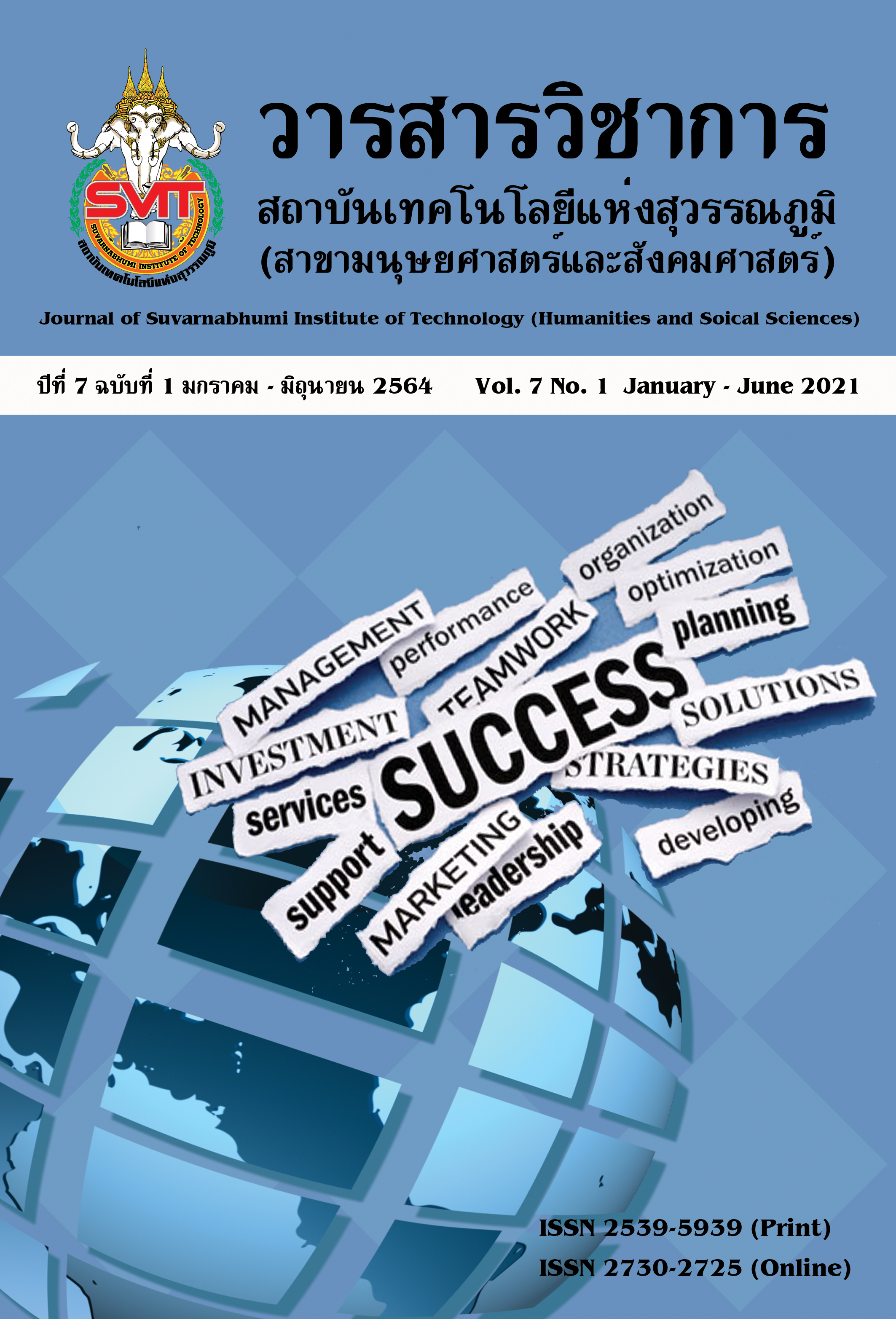THE MODEL OF COMPETENCIES OF THE PILOT-IN-COMMAND FOR MULTI-CREW PILOT-AEROPLANE, FLIGHT EXPERIENCES AND INNOVATIVE MANAGEMENT TOWARDS THE EFFECTIVENESS OF FLIGHT OPERATIONS IN THALAND
Keywords:
competency, innovative management, pilot -in -command for multi-crew pilot –aeroplane, flight experiences, flight operationsAbstract
The objectives of this research were to 1) study the competency level of the pilot -in -command for multi-crew pilot -aeroplane, flight experiences and innovative management towards the effectiveness of flight operations in Thailand. 2) study the influences of the competency of the pilot -in -command for multi-crew pilot -aeroplane, flight experiences and innovative management on the effectiveness of flight operations in Thailand. This research employed quantitative and qualitative research methods. In the quantitative research part, the sample consisted of 300 pilot -in -command for multi-crew pilot-aeroplane in Thailand. They were selected by multi-stage sampling. The sample size was determined based on 20 times the observed variables. Data were collected via the use of a questionnaire and were analysed using a structural equation model. For the qualitative research component, in-depth interviews were conducted with 17 key informants, including experts and management in airlines business.
The research findings indicated that:
1. the competency level of the pilot -in -command for multi-crew pilot - aeroplane, flight experiences, innovative management and the effectiveness of flight operations in Thailand were rate at a high level = 3.856, 3.836,3.831 and 3.824 accordingly.
2. the competency of the pilot -in -command for multi-crew pilot - aeroplane (λ = .53) flight experiences (λ = .29) and innovative management (λ= .19) had influences on the effectiveness of flight operations in Thailand at 0.05 level of statistics significance.(R2=.94)
References
กรมการบินพลเรือน (บพ.). (2553). ประกาศกรมการบินพลเรือน เรื่องหลักสูตรนักบินผู้ช่วยเครื่องบิน และครูการบินที่ทำการสอน.
กำพล ภิญโญกุล. (2558). การพัฒนาตัวแบบสมรรถนะนักบินพาณิชย์ในประเทศไทย. (วิทยานิพนธ์ปรัชญาดุษฎีบัณฑิต). คณะรัฐศาสตร์, มหาวิทยาลัยนอร์ทกรุงเทพ.
ฉัตรชัย กองกุล (2559). วัฒนธรรมการบริหารจัดการของบริษัทการบินไทย จำกัด (มหาชน) สู่การเป็นองค์การที่มีผลการปฏิบัติงานเป็นเลิศด้านการบริการ. (วิทยานิพนธ์ปรัชญาดุษฎีบัณฑิต สาขาวิชาการจัดการ). บัณฑิตวิทยาลัย, มหาวิทยาลัยสยาม.
สมาคมขนส่งทางอากาศระหว่างประเทศ. (2558). บทสรุปวิเคราะห์ธุรกิจการบินในภูมิภาคเอเชียตะวันออกเฉียงใต้. สืบค้นเมื่อ 1 เมษายน 2558, จาก www. Iata.co.th
สำนักงานการบินพลเรือนแห่งประเทศไทย (กพท.). (2559). ประกาศสำนักงานการบินพลเรือนแห่งประเทศไทย เรื่อง หลักสูตรการฝึกอบรมสำหรับผู้ประจำหน้าที่ในอากาศ - เครื่องบิน (Flight Crew Member Training Programmes-Airplane) พ.ศ. 2559.
สุกัญญา รัศมีธรรมโชติ. (2551). การจัดการทรัพยากรมนุษย์ด้วย Competency Based HRM. กรุงเทพฯ: ซีเอ็ดยูเคชั่น จำกัด.
อภิรดี เลาหวิเชียร. (2555). คุณลักษณะของนักบริหารกับประสิทธิผลของภาวะผู้นำ กรณีเปรียบเทียบระหว่างบริษัท วิทยุการบินแห่งประเทศไทย จำกัด และบริษัท การบินไทย จำกัด (มหาชน). คณะรัฐศาสตร์ มหาวิทยาลัยรามคำแหง
อาทิตย์ นาคีรักษ์. (2555). การพัฒนาแบบจำลองภาวะผู้นำกัปตันของกัปตัน บริษัท การบินไทย จำกัด (มหาชน). สาขาการบริหารการพัฒนา (การพัฒนานักบริหารระดับสูง), มหาวิทยาลัยราชภัฏสวนสุนันทา
Burian, B., Orasanu, J., & Hitt, J. (2000). Weather-related decision errors: differences across flight types. Proceedings of the 14th Triennial Congress of the International Ergonom-ics Association/44th Annual Meeting of the Human Factors and Ergonomics Society. Santa Monica, CA: HFES.
Cees,B.M. van Reil & Fombrun, C.J. (2007). Essentials of Corporate Communications, Imple-menting practices for effective reputation management/Routledge.UK.
Dong-Shang Chang, Sheng-Hung Chen, Chia-Wei Hsu & Allen H. Hu,. (2015). Identifying Strate-gic Factors of the Implantation CSR in the Airline Industry: The Case of Asia-Pacific Air-lines. Sustainability 2015, 7, 7762-7783; doi:10.3390/su7067762
ICAO Annex 16, Environmental Protection, Volume I: Aircraft Noise, 6th Edition, July 2011 ICAO Annex 16, Environmental Protection, Volume II: Aircraft Engine Emissions, 3rd Edition, July 2008 ICAO Annex 19, Safety Management, 1st Edition, July 2013
John Whitelegg. (2000). AVIATION: the social, economic and environmental impact of flying: University of York, England.
Li, G., Baker, S. P., Grabowski, J. G., & Rebok, G. W. (2001). Factors associated with pilot error in aviation accidents. Aviation, Space and Environmental Medicine. Aerospace Medical Association.
Moolchandani, Kushal A. (n.d.). Impact of environmental constraints and aircraft technology on airline fleet composition. Purdue University, ProQuest Dissertations Publishing, 2012. 1535109.
Raymond A. Noe. (2010). Employee Training and Development (5th Ed). New York: McGraw-Hill.
Steven T. Sparks. (2008). Attention and Distraction in pilots: A study of the relationship be-tween flight experience, aircraft control, and distraction management among pilots. Oklahoma State University, Dissertations Publishing, 3342186.
Downloads
Published
Issue
Section
License
บทความที่ได้รับการตีพิมพ์เป็นลิขสิทธิ์ของวารสารวิชาการ สถาบันเทคโนโลยีแห่งสุวรรณภูมิ
ข้อความที่ปรากฏในบทความแต่ละเรื่องในวารสารวิชาการเล่มนี้เป็นความคิดเห็นส่วนตัวของผู้เขียนแต่ละท่านไม่เกี่ยวข้องกับสถาบันเทคโนโลยีแห่งสุวรรณภูมิ และคณาจารย์ท่านอื่นๆในสถาบันฯ แต่อย่างใด ความรับผิดชอบองค์ประกอบทั้งหมดของบทความแต่ละเรื่องเป็นของผู้เขียนแต่ละท่าน หากมีความผิดพลาดใดๆ ผู้เขียนแต่ละท่านจะรับผิดชอบบทความของตนเองแต่ผู้เดียว





